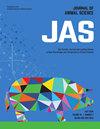The effect of dietary camelina, flaxseed, and canola oil supplementation on skin fatty acid profile and immune and inflammatory responses in healthy adult horses
IF 2.7
2区 农林科学
Q1 AGRICULTURE, DAIRY & ANIMAL SCIENCE
引用次数: 0
Abstract
Camelina sativa is an oilseed crop rich in α-linolenic acid (ALA), an n-3 fatty acid (FA), and is resistant to harsh climates and pests. Previously, supplementation with camelina oil (CAM) in horses had no adverse effects on basic health parameters and had comparable skin and coat parameters as both flaxseed oil (FLX) and canola oil (OLA). Further, the plasma FA profile of horses was reflective of their respective treatment oil. The objective of this study was to assess the effects of dietary CAM supplementation on skin FA profile, immune, and inflammatory responses as compared to two commonly used oils in the equine industry, OLA and FLX, in healthy adult horses. Twenty-four adult horses, from two separate herds, were enrolled in this experiment. The horses underwent a gradual 4-week fat acclimation period to sunflower oil (~0.28% ALA), then were supplemented with either CAM (~34.9% ALA), OLA (~12.0% ALA), or FLX (56.0% ALA) at an inclusion rate of 0.37 g/kg body weight (BW) per day for an additional 16 weeks. Immune and inflammatory responses were assessed by measuring antibody concentrations across time after sensitization to keyhole limpet hemocyanin (KLH) at weeks 10 and 12, and a subsequent delayed-type hypersensitivity (DTH) challenge. Skin biopsy samples were collected at weeks 0, 8 and 16, and FA composition was determined using gas chromatography. All data were analyzed as a repeated measures ANOVA using PROC GLIMMIX in SAS. Antibody and DTH responses to KLH did not differ among groups (P = 0.262 and 0.813, respectively), and no treatment by time effects were observed (P = 0.764 and P = 0.817, respectively). Most FA in the skin changed in composition across time, with the sum of n-3 FA increasing (P < 0.001) and the sum of n-6 FA and skin n-6:n-3 ratio decreasing over time (P < 0.001 and P < 0.001, respectively). Only dihomo-γ-linolenic acid (P = 0.025) and the sum of n-3 FA (P = 0.031) had treatment by week effects. At week 16, the composition of eicosapentaenoic acid in skin was greater in FLX than OLA, but neither differed from CAM (P = 0.049). These results suggest that ALA supplementation may beneficially impact skin FA profile. However, due to the small differences in n-3 FA and n-6:n-3 ratio among CAM, FLX, and OLA, a comparable skin FA profile, immune, and inflammatory response was observed among treatments at a dose of 0.37 g oil/kg BW. Therefore, CAM may be a suitable alternative to FLX in equine diets for the delivery of ALA.求助全文
约1分钟内获得全文
求助全文
来源期刊

Journal of animal science
农林科学-奶制品与动物科学
CiteScore
4.80
自引率
12.10%
发文量
1589
审稿时长
3 months
期刊介绍:
The Journal of Animal Science (JAS) is the premier journal for animal science and serves as the leading source of new knowledge and perspective in this area. JAS publishes more than 500 fully reviewed research articles, invited reviews, technical notes, and letters to the editor each year.
Articles published in JAS encompass a broad range of research topics in animal production and fundamental aspects of genetics, nutrition, physiology, and preparation and utilization of animal products. Articles typically report research with beef cattle, companion animals, goats, horses, pigs, and sheep; however, studies involving other farm animals, aquatic and wildlife species, and laboratory animal species that address fundamental questions related to livestock and companion animal biology will be considered for publication.
 求助内容:
求助内容: 应助结果提醒方式:
应助结果提醒方式:


